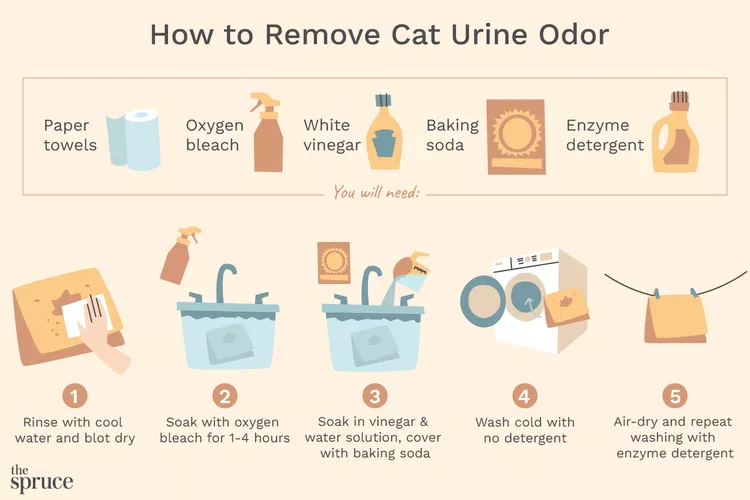How to Get Cat Pee Smell Out of Clothes & Bedding

Your cat may have occasional accidents and soil your clothes or bedding with urine. Their urine often has an odor that is very hard to remove, especially if it is dried and set in. You can, however, remove cat urine and its odors from any washable fabrics. The same method can be used for other types of urine. After dealing with the immediate problem, also consider behavioral or health issues that might be causing your cat to soil laundry in this way.
To fully remove the cat pee smell from clothes, you'll need to follow three basic steps: Pretreating the urine-soaked fabric, washing the soiled garment in vinegar, and then washing the clothing again in an enzyme-based detergent. Fortunately, all of the required supplies are basic items you likely have at home already. Here's how to tackle urine odor in clothing.
Pretreating
Throwing urine-stained clothing or fabrics directly into the washing machine isn't a good idea since cat urine has a way of setting in its odors. If added to a general laundry load, you might even find that the urine-stained items contaminate an entire load of laundry with its scent. It's best to pretreat the urine first before moving to the next step.
- Rinse out the spot with clean, cool water. Blot the stained area dry with paper towels. Do not scrub at the stain, since this can drive it deeper into the fabric. Your goal here is to remove as much of the urine as possible before moving to the cleaning stages.
- Fill a sink with water and add a half-cup of oxygen bleach, such as Oxiclean. Do not use traditional chlorine bleach, as this can damage clothing. Mix the oxygen bleach thoroughly into the water, then soak the urine-stained items in the water for one to four hours.
Warning
A variety of odor-removing products are available as part of the pretreatment but never use a product containing ammonia to clean urine stains. Cats are likely to mistake the ammonia scent for urine and may then repeatedly urinate in the same place.
Vinegar Wash
For the best results, use a two-part cleaning process to remove urine stains and odor. The first part of this process is a vinegar wash.
- Mix one cup of white vinegar with one cup of water (one to one). Coat the urine-stained item with this solution and allow it to sit for a few minutes.
- Cover the stained area with baking soda, if you wish. Baking soda will work along with vinegar to absorb and neutralize odor.
- Wash the urine-stained items in a washing machine set on cold or lukewarm water. Do not add laundry detergent for this washing. Do not use warm or hot water, as this can set in the stain and odor.
- Air-dry the urine-stained items. This can take a full 24 hours if you are drying indoors. Do not use a clothes dryer, because any heat can serve to set in the odor permanently.
Laundering
By now, a good deal of the stain and odor has been removed, and you can move to traditional washing.
- Wash the urine-stained items in cool water, using an enzyme-based detergent. Enzyme-based detergents are known to work on organic-based stains. The enzymes effectively "eat" organic material, including cat urine. Detergent labels will indicate if they contain enzymes—most cold-water detergents are of this type.
- Air-dry the items once again. Once they are fully dry, smell the items carefully for any lingering odors. If the urine has fully dried, you may need to repeat the final laundering step.
Consider Your Cat's Health
To avoid future incidents, you must address the problem with your cat. When cats urinate in places other than the litter box, it very often indicates a health or behavioral issue.
Begin by taking your cat to the vet. Aside from a dirty litter box, a urinary tract problem is the most common reason for litter box avoidance. You should rule out a health problem first. If your vet rules out a medical cause, then you will need to address the behavioral reasons for your cat's inappropriate urination.
Still Smell Cat Urine?
If your laundry has come out smelling fresh, but you still detect the lingering odor of cat urine in your home, you'll need to perform some detective work. It's possible the pet has marked floors, furniture, or other areas in your home.
Arm yourself with a urine detector or blacklight. Most blacklights work better in complete darkness, so work cautiously. Use the light to scan walls, floors, baseboards, furniture, and any other surfaces. Hold the light close to the surface for best results—urine stains will glow fluorescent white. Use chalk or sticky note paper to mark the areas where the blacklight reveals stains.
Once you've identified the soiled areas, use an odor-removal product to clean the area. After thoroughly cleaning, you can enjoy a freshly scented home once more.